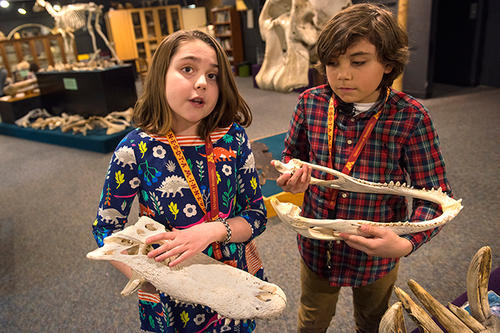
On the bright side, 10-year-old Maria and 9-year-old Miller Williams have inquisitive minds, an aptitude for science, and an utter fearlessness of all things creepy-crawly. On the downside, the home of their parents—U alumni Anna and Nick Williams—may soon be overrun with the bones, rocks, pelts, and other relics their children have accumulated.
Maria and Miller have been collecting natural history items since they were little, aided in part by their rock hound great aunt Becky and their hunter great uncle Ted, who holds a place in family lore by poking a hibernating bear. The siblings even share a bedroom to free up another room for their treasures. It also helps that Maria has known since the age of 2 that she wants to be a paleontologist (and the first to clone dinosaurs).
Last year, Maria and Miller decided to share their love of natural history—and their collection—with friends and neighbors. And in January they staged their own "Tiny Natural History Museum" near their home in Minnetrista, with more than 100 objects on display. Miller was in charge of admissions ($2 a head) and Maria was the docent, as it were.
Then they decided to turn over half of proceeds from the event ($125.71, to be exact) to their favorite museum—the U’s Bell Museum of Natural History, of course. In the process, they likely became some of the youngest, if not the youngest, donors the U has ever seen.
The U responded in kind, treating Miller and Maria to a behind-the-scenes tour of the Bell and its scientific collections on the St. Paul campus. In addition, they were presented magnifying loupes, Driven to Discover backpacks, and certificates proclaiming each of them an honorary "Bell Museum Tiny Curator."
Both were more than a little excited as they learned about the Bell from George Weiblen, its scientific director and curator of plants, and museum associate Jennifer Menken. The kids got to show off some of their own scientific knowledge, and saw new species of birds and mammals from Minnesota and across the globe—only a fraction of the museum's four-plus million specimens.
“I think it’s pretty cool seeing all this stuff around, trying to guess what it is,” beamed a wide-eyed Maria in the crowded scientific collections room in St. Paul. “There’s just too much to take in. … Our museum, you can take it in a little easier than this.”
There’s something to be said for tiny museums. And much to look forward to from these tiny curators.
- Categories:
- Education





